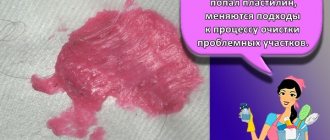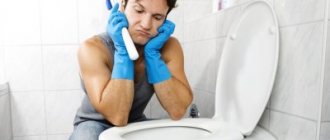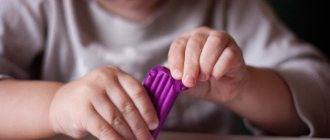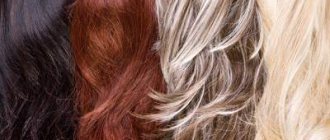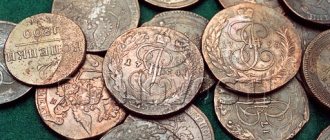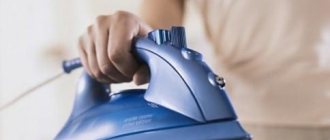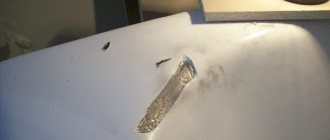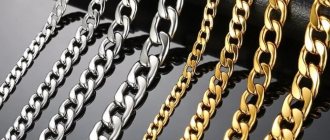Savig
12151 0 2
Savig July 11, 2017Specialization: master of interior finishing works. I am well versed in power tools for repair and construction. Formerly a teacher at a radio engineering college.
Removing plasticine from wallpaper is a troublesome task, but quite doable.
Are you wondering how to remove plasticine from wallpaper? The experience I have accumulated allows me to say that anyone can do it. A detailed description of the most popular methods will help me prove this.
Cleaning with improvised means
If you find a trace of plasticine or a bright lump stuck on the wall, you need to act quickly enough.
If the contamination is absorbed into the deep layers, it will be very difficult to cope with the problem, and in some cases it is simply impossible, and you will have to re-glue the damaged panel.
The first step is to remove as much volume as possible, acting extremely carefully.
Household hair dryer
In order to eliminate the mark from the plasticine mass, you can use a hairdryer to warm it up. In addition to this, you will need the following materials:
- highly absorbent wipes;
- water;
- soap.
Operating principle:
The hairdryer switches to heating mode.- The bell of the device is directed from a distance of 10-15 cm to the area with a trace of plasticine. If the damaged area is large, then it needs to be cleaned gradually.
- Warm air will soften the plasticine, and it will be easier to remove it with prepared napkins.
- After the contamination has been removed, the area is washed with soapy water of any concentration. During the processing process, you must try to completely remove all greasy marks.
- Dry the surface of the wallpaper with a hairdryer.
When removing plasticine heated by a hairdryer, the napkins should be replaced very often to prevent smearing.
Freezing
Freezing can help remove the plasticine mass from the wallpaper. If ice is not available, you can replace it with frozen foods.
For processing you need to prepare:
- napkins;
- sharp knife;
- soap and water.
Procedure:
- Apply ice to the stained area so that the plasticine crystallizes and becomes hard.
- Using a sharp knife, carefully remove the plasticine.
- Wash the remaining grease stain with soapy water.
- Dry the surface.
Removing plasticine from wallpaper by freezing with liquefied propane - in the video:
White Spirit
This product is widely used as a cleaner for various surfaces. You can try applying white spirit on wallpaper only after testing.
Moisten a swab or napkin with the preparation and go over the stain with gentle blotting movements.
Vegetable oil
Vegetable oils (olive, sunflower and others), which are always found in the kitchen, can be used to remove colored marks from children's plasticine. This method has its pros and cons.
Procedure:
- Soak a rag or napkin in vegetable oil.
- Apply the product to the stain.
- Scrub the area, working gently with an old toothbrush.
- Wash with soapy water to remove greasy marks.
Washing plasticine with oil from non-woven wallpaper - in the video:
Removal with plasticine
Wallpaper that has a pronounced texture and embossed surface is difficult to clean due to the danger of damaging the voluminous pattern. A technique using white plasticine can help.
The mashed light lump must be pressed to the site of contamination and removed with a sharp movement. It will not be possible to remove all the colored plasticine at once, so the procedure will have to be repeated, each time using a new piece of white plasticine.
After removing the color mass, a greasy mark remains on the wallpaper . Soapy water or using a stain remover that is active against greasy marks will help remove it.
Processing using this method is very painstaking and takes a lot of time. For large stains this method will be ineffective.
Removing plasticine from wallpaper
It is important to understand that there is a significant difference between smooth and embossed wallpaper. The algorithm of actions of the apartment owner depends on the texture of the surface. It is easier to work with smooth coatings, but even here the degree of contamination must be taken into account. Plasticine is not plastic, you are dealing with a soft material. We list the methods that people use in relation to smooth coatings:
- heating (hairdryer or iron);
- freezing;
- manual removal;
- chemical exposure.
Scraping plasticine from a relief pattern is a thankless task. Along with the stain, you risk removing the pattern itself. Therefore, you need to act subtly - treat like with like. Proceed as follows:
- Tear off a piece of white plasticine and stick it to the problem area.
- Make sure that the clean part of the wall is not affected.
- With a sharp movement, tear off both pieces of plasticine.
- Heat any remaining dirt with a hairdryer.
- Remove the greasy mark with a sponge (it should be soaped first).
Application of special chemistry
The plasticine mark is a greasy colored stain. Even if the sticky mass was removed from the wallpaper very quickly, the mark may remain. You can use special preparations to remove stains.
Expert stain remover, fats and sauces Dr. Beckmann
Under TM Dr. Beckmann produces a large range of targeted products that allow you to remove a certain type of contaminant with the highest quality possible. The “Fats and Sauces” stain remover can handle greasy stains.
Thanks to the inclusion of a combination of surfactants, the drug breaks down fats, as a result of which the stain disappears. Apply the product undiluted with blotting movements to the contaminated area. The price of a 50 ml bottle is up to 200 rubles. Read reviews here, here and here.
Axiom Foam interior cleaner
Axiom is a cleaner designed for treating car interiors . But it can also be used to remove plasticine from wallpaper and other surfaces.
The drug contains alcohol, various special additives, aliphatic hydrocarbons, etc. The cleaner is applied directly from the bottle to the stained area.
Car chemicals used to clean the interior can damage the wallpaper, so preliminary testing of it on an inconspicuous fragment of the surface is a prerequisite. Price – about 200 rubles for 800 ml.
Vanish Gold Oxi Action
Oxygen-containing stain remover should be used diluted in the following proportion:
- 5 tbsp. l. water;
- 1 tbsp. l. powder.
The product is stirred until smooth and applied only when the granules are completely dissolved. It is convenient to carry out the treatment with an old toothbrush.
After removing the trace, the remaining product is washed off with clean water, and the surface of the wallpaper is dried with a hairdryer. Cost – 660 rubles per plastic container. Read reviews here, here and here.
How to wash plasticine mass from skin and hair
In addition to the fact that the child scatters plasticine all over the house while modeling, he also manages to get dirty himself from head to toe. Let's look at how to painlessly wash away dirt and get your baby in order.
How to wash your hands
To wash the child’s hands from dirt, the mother will need to remember a few simple methods:
- first you can try the simplest gentle method - washing your hands in warm, but not hot water with baby soap;
- persistent stains can be easily wiped off the skin with a cotton swab or a clean soft cloth generously soaked in any vegetable oil;
- nourishing fatty cream will dissolve plasticine;
- a fairly aggressive method that can only be used to wash the plasticine mass from the skin of an adult - a detergent, for example, Fairy.
How to clean your hair
With hair, the situation is a little more complicated, especially for girls. Improper removal of the plasticine mass can damage your hair. Let's list how to wash plasticine from your hair without loss:
- If the length of the hair is above the shoulders, you will need to wash the child's hair several times with a softening shampoo.
- Before removing material from long hair, you will need to first manually clean it from large, easily separated clumps. Then you will need to wipe the damaged curl with a cotton swab moistened with alcohol-containing lotion or perfume. After this, you need to carefully comb out the remaining plasticine mass with a comb with fine, fine teeth. At the final stage, you will need to go over the part to be cleaned with vegetable oil. And at the end of the procedure, wash the child’s hair in the usual way.
How to clean different types of coating?
When choosing a surface cleaning method, it is necessary to take into account the type of wallpaper and the texture of the material. The easiest way is to remove the plasticine and clean the base from the following wallpaper:
- vinyl;
- non-woven;
- liquid;
- acrylic.
Textile surfaces are more difficult to clean, since such wallpaper is recommended to be cleaned only dry. Paper wallpaper is also difficult, since its surface is very easily damaged. Therefore, cleaning is carried out only in one direction, and without the use of force.
Paper
The surface of paper wallpaper is smooth, but very demanding in terms of cleaning methods. If handled carelessly and intensively, this coating is easily damaged.
Methods of influence:
- It is better to carefully scrape off the bulk of the plasticine with a plastic scraper.
- The remaining creative product should be collected using the hairdryer method.
- Soap solution and stain removers can be used very limitedly, avoiding over-wetting the paper.
Washable
To process thick washable wallpaper, you can use any of the above methods. The surface texture and type of finish should be taken into account, for example, contrasting patterns, the presence of sparkles, etc.).
Textile
If the surface of the wallpaper cannot be treated wet, it should be cleaned without using water. To bring an expensive coating back to normal condition, it is better to contact a cleaning company , entrusting the processing to professionals.
Remaining stains
To remove stains from plasticine at home, take into account many factors: the material from which the finishing is made, the degree of contamination, the age of the drawing.
Iron vs plasticine
The latter is especially important, because the modeling material contains dyes. Once the pigment is absorbed into the structure of the finish, it cannot be removed.
Note ! The main condition for cleaning wall coverings is timeliness. The less the finishing material has contact with plasticine, the easier and better the stains will be washed off.
Proven methods:
- hot (hairdryer, iron);
- cold;
- chemical;
- helper.
Each method is highly effective, but be sure to follow the processing pattern.
Mechanical removal
Small pieces can also be removed by hand.
Carefully remove small pieces of plasticine
Under no circumstances should you use a comb - you will only hurt the child.
In one hand you need to take a strand of hair on which the plasticine has stuck, and with the other hand, carefully break the pieces. This works well when the material has already dried out and is crumbling. In this case, it is important not to pull the child by the strands, but to hold them as tightly as possible in front of the place where the dirt has dried.
Advice!
The mechanical method of removing plasticine should not be used if it has stuck to the hair directly near the roots. Any movement can provoke sharp pain, in which case you need to use the home methods described below.
